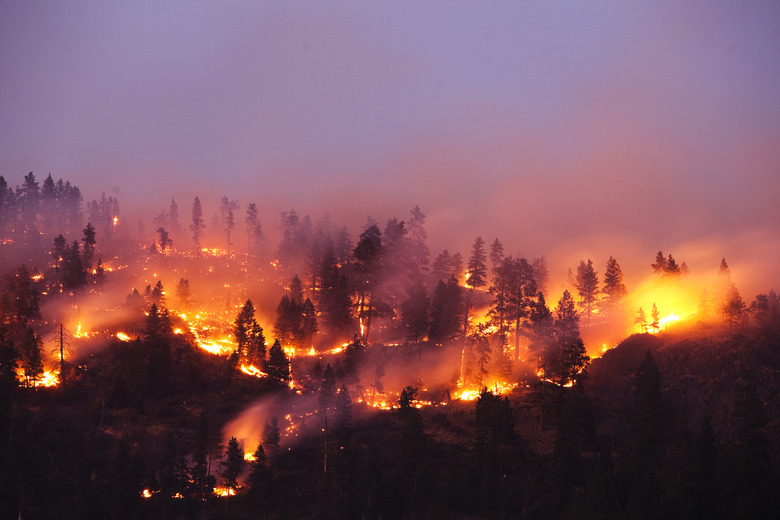Steps Of Primary & Secondary Succession
Ecological succession is the change over time in the composition of species that make up an ecosystem. Ecological succession in an ecosystem is caused by disturbances that create new environmental conditions. The changes in environmental conditions give new species the opportunity to colonize an area.
Two Types of Succession: Primary Succession and Secondary Succession
Two Types of Succession: Primary Succession and Secondary Succession
Primary succession refers to the colonization of barren areas where no life previously occurred. Secondary succession refers to the colonization of areas where a previous ecological community existed and was either partially or completely removed by a disturbance. A disturbance in an ecosystem allows for sunlight, nutrients and habitat to be available for new species to colonize an area.
Definition of Primary Succession
Definition of Primary Succession
Primary succession is the colonization of newly exposed or newly formed land with living organisms for the first time. Primary succession occurs in an area where no life previously existed, such as on bare rock, and introduces hardy organisms like lichen to an area that is devoid of life. The organisms that colonize a barren landscape cause small changes in the substrate that subsequently create the conditions necessary for other life forms to colonize the area.
An example of primary succession is the formation of new land on the Big Island of Hawaii from rock created by lava flows from erupting volcanoes. This process creates approximately 32 acres of new land each year. When this new rock is exposed, the process of primary succession begins.
Definition of Secondary Succession
Definition of Secondary Succession
Secondary succession is ecological succession that occurs where other living species previously existed.
Secondary succession occurs in areas where a disturbance has removed most or all of the species living in the previous ecological community but has left behind rich soil. Some species from the previous community may remain and recolonize the area after the disturbance, while others may be completely eliminated. There may be some habitat left over from the previous community that would invite a wider variety of species to colonize the area.
An example of secondary succession is the habitat that is created after a wildfire has damaged an ecosystem. Many of the plants and animals that lived in the previous ecosystem would be destroyed by fire. However, the organic matter left behind after a wildfire provides nutrition and habitat for a new succession of species.
Disturbances That Cause Primary Succession
Disturbances That Cause Primary Succession
Examples of disturbances that cause primary succession include retreating glaciers, volcanic eruption and the erosion of sand dunes. Human activity can also be a cause of primary succession, such as the creation of a paved surface. These types of disturbances leave bare rock exposed or otherwise accessible.
Disturbances That Cause Secondary Succession
Disturbances That Cause Secondary Succession
Examples of disturbances that cause secondary succession include natural disasters such as wildfire, floods and storms. Human disturbances such as clear-cutting can also cause secondary succession. Some disturbances affect only a small area, like the local damage caused by a single tree falling in the forest, while others affect entire landscapes. These disturbances damage the ecosystem but leave soil and nutrients behind.
Stages of Ecological Succession
Stages of Ecological Succession
There are several stages of ecological succession that make it possible for different types of living things to colonize an area. Both primary succession and secondary succession follow these similar steps when becoming colonized by living organisms. The difference between them in this case is the types of resources available: primary succession requires pioneer species to colonize bare rock while secondary succession requires colonization of an existing but damaged ecosystem.
First, a disturbance creates an opening in an ecosystem for new species to colonize a landscape. Next, organisms called pioneer species are the first to colonize the previously uninhabitable landscape. Once pioneer species have colonized an area, intermediate species are able to take hold in a community. Finally, a climax community stage is reached, and a more stable ecosystem is in place.
Pioneer Species
Pioneer Species
A pioneer species is any hardy organism capable of colonizing bare rock. These species have simple nutritional requirements and will convert the rock to soil and make it available for other living organisms. Lichen are frequently the first organisms to colonize an area, followed by moss and other small herbaceous plants. These species modify the substrate as they grow, providing habitat and nutrients that were not previously available. They are gradually replaced by more complex organisms as soil and shade are produced.
Intermediate Species
Intermediate Species
Intermediate species are plants and other organisms that continue to alter the habitat and soil composition as they colonize an area. Examples of intermediate species include perennial herbaceous plants, shrubby plants and softwood trees such as pine trees.
Climax Community
Climax Community
A climax community is an ecosystem that can sustain larger, more complex living organisms. Oak, hickory and other shade-tolerant trees and shrubs are examples of species that indicate a climax community. An ecological equilibrium within a community would mean that species are stable and are no longer being replaced, as in a mature forest community.
Cite This Article
MLA
Reinbold, Joan. "Steps Of Primary & Secondary Succession" sciencing.com, https://www.sciencing.com/steps-primary-secondary-succession-7248745/. 22 November 2019.
APA
Reinbold, Joan. (2019, November 22). Steps Of Primary & Secondary Succession. sciencing.com. Retrieved from https://www.sciencing.com/steps-primary-secondary-succession-7248745/
Chicago
Reinbold, Joan. Steps Of Primary & Secondary Succession last modified August 30, 2022. https://www.sciencing.com/steps-primary-secondary-succession-7248745/
